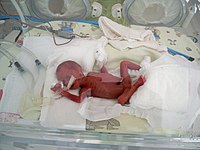
Photo from wikipedia
Objective To examine associations of birth weight with clinical and imaging indicators of cardiovascular health and evaluate mechanistic pathways in the UK Biobank. Methods Competing risk regression was used to… Click to show full abstract
Objective To examine associations of birth weight with clinical and imaging indicators of cardiovascular health and evaluate mechanistic pathways in the UK Biobank. Methods Competing risk regression was used to estimate associations of birth weight with incident myocardial infarction (MI) and mortality (all-cause, cardiovascular disease, ischaemic heart disease, MI), over 7–12 years of longitudinal follow-up, adjusting for age, sex, deprivation, maternal smoking/hypertension and maternal/paternal diabetes. Mediation analysis was used to evaluate the role of childhood growth, adulthood obesity, cardiometabolic diseases and blood biomarkers in mediating the birth weight–MI relationship. Linear regression was used to estimate associations of birth weight with left ventricular (LV) mass-to-volume ratio, LV stroke volume, global longitudinal strain, LV global function index and left atrial ejection fraction. Results 258 787 participants from white ethnicities (61% women, median age 56 (49, 62) years) were studied. Birth weight had a non-linear relationship with incident MI, with a significant inverse association below an optimal threshold of 3.2 kg (subdistribution HR: 1.15 (1.08 to 1.22), p=6.0×10–5) and attenuation to the null above this threshold. The birth weight–MI effect was mediated through hypertension (8.4%), glycated haemoglobin (7.0%), C reactive protein (6.4%), high-density lipoprotein (5.2%) and high cholesterol (4.1%). Birth weight–mortality associations were statistically non-significant after Bonferroni correction. In participants with cardiovascular magnetic resonance (n=19 314), lower birth weight was associated with adverse LV remodelling (greater concentricity, poorer function). Conclusions Lower birth weight was associated with greater risk of incident MI and unhealthy LV phenotypes; effects were partially mediated through cardiometabolic disease and systemic inflammation. These findings support consideration of birth weight in risk prediction and highlight actionable areas for disease prevention.
Journal Title: Heart
Year Published: 2022
Link to full text (if available)
Share on Social Media: Sign Up to like & get
recommendations!